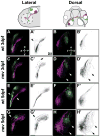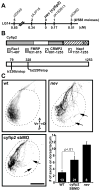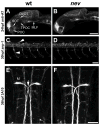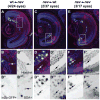nev (cyfip2) is required for retinal lamination and axon guidance in the zebrafish retinotectal system
- PMID: 20537992
- PMCID: PMC2914190
- DOI: 10.1016/j.ydbio.2010.05.512
nev (cyfip2) is required for retinal lamination and axon guidance in the zebrafish retinotectal system
Abstract
In the zebrafish retinotectal system, retinal ganglion cells (RGCs) project topographically along anterior-posterior (A-P) and dorsal-ventral (D-V) axes to innervate their primary target, the optic tectum. In the nevermind (nev) mutant, D-V positional information is not maintained by dorsonasal retinal axons as they project through the optic tract to the tectum. Here we present a detailed phenotypic analysis of the retinotectal projection in nev and show that dorsonasal axons do eventually find their correct location on the tectum, albeit after taking a circuitous path. Interestingly, nev seems to be specifically required for retinal axons but not for several non-retinal axon tracts. In addition, we find that nev is required both cell autonomously and cell nonautonomously for proper lamination of the retina. We show that nev encodes Cyfip2 (Cytoplasmic FMRP interacting protein 2) and is thus the first known mutation in a vertebrate Cyfip family member. Finally, we show that CYFIP2 acts cell autonomously in the D-V sorting of dorsonasal RGC axons in the optic tract. CYFIP2 is a highly conserved protein that lacks known domains or structural motifs but has been shown to interact with Rac and the fragile-X mental retardation protein, suggesting intriguing links to cytoskeletal dynamics and RNA regulation.
Copyright 2010 Elsevier Inc. All rights reserved.
Figures








Similar articles
-
Axon-Axon Interactions Regulate Topographic Optic Tract Sorting via CYFIP2-Dependent WAVE Complex Function.Neuron. 2018 Mar 7;97(5):1078-1093.e6. doi: 10.1016/j.neuron.2018.01.027. Neuron. 2018. PMID: 29518358 Free PMC article.
-
Matrix metalloproteinase 14 in the zebrafish: an eye on retinal and retinotectal development.PLoS One. 2013;8(1):e52915. doi: 10.1371/journal.pone.0052915. Epub 2013 Jan 9. PLoS One. 2013. PMID: 23326364 Free PMC article.
-
Zebrafish mutations affecting retinotectal axon pathfinding.Development. 1996 Dec;123:427-38. doi: 10.1242/dev.123.1.427. Development. 1996. PMID: 9007260
-
Retinal Ganglion Cell Axon Wiring Establishing the Binocular Circuit.Annu Rev Vis Sci. 2020 Sep 15;6:215-236. doi: 10.1146/annurev-vision-091517-034306. Epub 2020 May 12. Annu Rev Vis Sci. 2020. PMID: 32396770 Review.
-
Wiring the Binocular Visual Pathways.Int J Mol Sci. 2019 Jul 4;20(13):3282. doi: 10.3390/ijms20133282. Int J Mol Sci. 2019. PMID: 31277365 Free PMC article. Review.
Cited by
-
Transcript diversification in the nervous system: a to I RNA editing in CNS function and disease development.Front Neurosci. 2012 Jul 9;6:99. doi: 10.3389/fnins.2012.00099. eCollection 2012. Front Neurosci. 2012. PMID: 22787438 Free PMC article.
-
Cyfip2 controls the acoustic startle threshold through FMRP, actin polymerization, and GABAB receptor function.bioRxiv [Preprint]. 2024 Feb 5:2023.12.22.573054. doi: 10.1101/2023.12.22.573054. bioRxiv. 2024. PMID: 38187577 Free PMC article. Preprint.
-
The ubiquitin ligase PHR promotes directional regrowth of spinal zebrafish axons.Commun Biol. 2019 May 22;2:195. doi: 10.1038/s42003-019-0434-2. eCollection 2019. Commun Biol. 2019. PMID: 31149640 Free PMC article.
-
Neuronal function and dysfunction of CYFIP2: from actin dynamics to early infantile epileptic encephalopathy.BMB Rep. 2019 May;52(5):304-311. doi: 10.5483/BMBRep.2019.52.5.097. BMB Rep. 2019. PMID: 30982501 Free PMC article. Review.
-
Deficiency of the neurodevelopmental disorder-associated gene Cyfip2 alters the retinal ganglion cell properties and visual acuity.Hum Mol Genet. 2022 Feb 21;31(4):535-547. doi: 10.1093/hmg/ddab268. Hum Mol Genet. 2022. PMID: 34508581 Free PMC article.
References
-
- Avanesov A, Malicki J. Approaches to study neurogenesis in the zebrafish retina. Methods Cell Biol. 2004;76:333–84. - PubMed
-
- Baier H, Klostermann S, Trowe T, Karlstrom RO, Nusslein-Volhard C, Bonhoeffer F. Genetic dissection of the retinotectal projection. Development. 1996;123:415–25. - PubMed
-
- Bardoni B, Mandel JL. Advances in understanding of fragile X pathogenesis and FMRP function, and in identification of X linked mental retardation genes. Curr Opin Genet Dev. 2002;12:284–93. - PubMed
-
- Bogdan S, Grewe O, Strunk M, Mertens A, Klambt C. Sra-1 interacts with Kette and Wasp and is required for neuronal and bristle development in Drosophila. Development. 2004;131:3981–9. - PubMed
Publication types
MeSH terms
Grants and funding
LinkOut - more resources
Full Text Sources
Molecular Biology Databases
Miscellaneous

